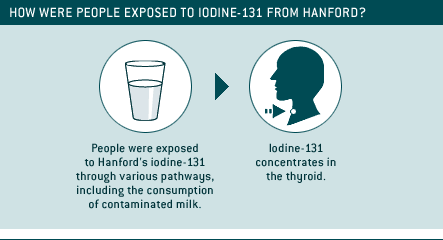HTDS Guide – Overview
‹View Table of Contents
Return to The Hanford Thyroid Disease Study page
About the Hanford Thyroid Disease Study
The Hanford Thyroid Disease Study (HTDS) is a scientific study conducted to determine whether the risk of thyroid disease is increased among people exposed to radioactive iodine (iodine-131) from the Hanford Nuclear Site in Washington from 1944 through 1957.
The question was: “Did exposure to iodine-131 result in increased incidence of thyroid disease?”
Study Focus – Iodine-131 was the primary source of radiation for many people exposed to Hanford’s radiation releases. Since iodine-131 concentrates in the thyroid gland when it is inhaled or consumed in contaminated food, the HTDS focused on thyroid disease.
Research Team – The HTDS was managed by the Centers for Disease Control and Prevention (CDC), an agency in the U.S. Department of Health and Human Services. The Fred Hutchinson Cancer Research Center in Seattle, Washington conducted the scientific and technical work. The HTDS Final Report was released in June 2002.
What Happened at Hanford
The Hanford Nuclear Site was built in the 1940s in southeastern Washington State to produce plutonium for nuclear weapons.
In the mid 1980s, as a result of public requests, the U.S. Department of Energy released previously unavailable or classified documents about past operations at Hanford. The information showed that large amounts of iodine-131 and other radioactive materials were released into the air from Hanford from 1944 through 1957.
Concerns about the possible health effects of Hanford’s radiation led to a decision by Congress to mandate the HTDS in 1988.

To study the health effects of Hanford’s iodine-131, researchers investigated a group of people with a wide range of radiation doses to the thyroid. In this way, researchers could compare groups of people with similar characteristics (such as lifestyle and diet) but different levels of exposure.
Participant Selection – Other studies suggest that young children may be the most susceptible to the effects of radiation on the thyroid gland. Therefore, the HTDS selected participants who were young children when Hanford releases of iodine-131 were highest. Scientists also ensured that the HTDS participants included many people who lived in areas around Hanford where the highest thyroid radiation doses occurred.
From a sampling of 5,199 birth records, scientists were able to locate 3,440 people who were both willing to participate and able to provide the necessary data for evaluation of thyroid disease.
Data Collection – Participants underwent complete evaluations for thyroid disease, and provided detailed information about the places they lived and the quantities and sources of the food and milk they consumed.
Data Analysis – For each type of thyroid disease, the research team examined how the rates of disease varied in relation to participants’ estimated radiation doses from Hanford’s iodine-131.
The HTDS data show that the risk of thyroid disease was about the same regardless of the radiation doses people received from Hanford. In other words, no associations between Hanford's iodine-131 and thyroid disease were observed.
- Researchers studied all types of thyroid disease, a disease of the parathyroid glands, and abnormalities of the thyroid gland that can be seen on ultrasound examinations.
- The percentages of people with each kind of thyroid disease or with ultrasound abnormalities were about the same regardless of their estimated radiation dose from Hanford's iodine-131.
The findings do not prove that Hanford radiation had no effect on the health of the area population. However, they show that if there is an increased risk of thyroid disease from exposure to Hanford's iodine-131, it is probably too small to observe using the best epidemiologic methods available.
Thyroid disease was found in the study population. This was expected because thyroid disease is common in other populations, especially among older people and women.
Based on a review of other studies, researchers found that the rates of thyroid disease in the HTDS population were generally consistent with the rates of disease detected in other populations.
CDC formed a committee of scientists and members of the public to advise CDC on the design and implementation of the study. Members of the public and public interest groups provided input in public meetings and written comments to CDC throughout the study.
At the request of CDC, the National Academy of Sciences peer reviewed the HTDS at key points in the study. Peer review is an independent analysis of a study that provides confidence that the correct methods are being used.
About Thyroid Disease
The thyroid gland is located at the base of the neck (see figure below).
Thyroid disease is common in the general population. Thyroid disease includes functional disorders and abnormal growth in the gland, including cancer. Most thyroid problems can be detected and treated.
If you are concerned about exposure to iodine-131 from Hanford or experience thyroid disease symptoms, you are encouraged to see your doctor for a thyroid evaluation.
